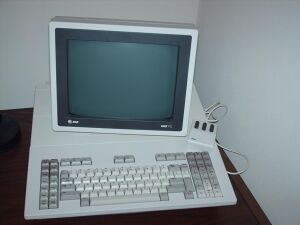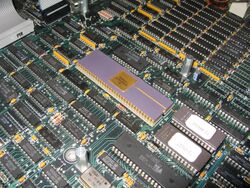Engineering:AT&T UNIX PC
 AT&T UNIX PC | |
| Manufacturer | Convergent Technologies[2] |
|---|---|
| Type | Professional Computer |
| Release date | March 26, 1985[3] |
| Introductory price | US$5,095 (equivalent to $12,100 in 2019) - US$7,290 (equivalent to $17,300 in 2019)[3][4] |
| Media | 5¼-inch floppy disks, optional QIC tapes |
| Operating system | AT&T UNIX v3.51[1] (Based on SVR2) |
| CPU | Motorola 68010 with custom MMU clocked at 10 MHz |
| Memory | 512 KB to 4 MB RAM |
| Storage | 10 MB, Optional 20 MB, 40 MB,[2] and 67 MB hard drives[1] |
| Display | 12 inches (30 cm), 720 x 348 |
| Input | Keyboard, 3-button Mouse |
| Connectivity | RS-232 port, Parallel port, 3 phone jacks |
| Mass | 40 lb (18 kg) |
The AT&T UNIX PC is a Unix desktop computer originally developed by Convergent Technologies[2] (later acquired by Unisys),[5][1] and marketed by AT&T Information Systems in the mid- to late-1980s. The system was codenamed "Safari 4"[6] and is also known as the PC 7300, and often dubbed the "3B1". Despite the latter name, the system had little in common with AT&T's line of 3B series computers. The system was tailored for use as a productivity tool in office environments and as an electronic communication center.[7]
Hardware configuration
- 10 MHz Motorola 68010 (16-bit external bus, 32-bit internal) with custom, discrete MMU[2]
- Internal MFM hard drive, originally 10 MB,[3] later models with up to 67 MB[1]
- Internal 5-1/4" floppy drive[2]
- At least 512 KB RAM on main board (1 MB or 2 MB were also options), expandable up to an additional 2 MB via expansion cards[2]
- Monochrome green phosphor 12-inch (300 mm) monitor[2]
- Internal 300/1200 bit/s modem[2]
- RS-232 serial port[2]
- Centronics parallel port[2]
- 3 S4BUS expansion slots[2]
- 3 phone jacks[2]
PC 7300
The initial PC 7300 model offered a modest 512 KB[2] of memory and a small, low performance 10 MB hard drive.[3] This model, although progressive in offering a Unix system for desktop office operation, was underpowered and produced considerable fan and drive bearing noise even when idling. The modern-looking "wedge" design by Mike Nuttall was innovative, and the machine gained notoriety appearing in numerous movies and TV shows as the token "computer".[8]
AT&T 3B/1
An enhanced model, "3B/1", was introduced in October 1985 starting at US$8,495 (equivalent to $20,200 in 2019).[9][1] The cover was redesigned to accommodate a full-height 67 MB hard drive.[1] This cover change added a 'hump' to the case, expanded onboard memory to 1 or 2 MB, as well as added a better power supply.[1]
S/50
Convergent Technologies offered an S/50 which was a re-badged PC 7300.[10]
Olivetti AT&T 3B1
British Olivetti released the "Olivetti AT&T 3B1 Computer" in Europe.[11]
Operating system

The operating system is based on Unix System V Release 2,[2] with extensions from 4.1 and 4.2 BSD, System V Release 3 and Convergent Technologies.[1] The last release was 3.51.[1]
Programming languages
- AT&T BASIC[1]
- dBase III[3]
- GNU C++
- LISP
- LPI C[3][1]
- LPI COBOL[3]
- LPI DEBUG (debugger)
- LPI Fortran[3][1]
- LPI Pascal[3][1]
- LPI PL/I[3]
- Microsoft BASIC[1][3]
- RM/COBOL[1]
- RM/Fortran[1]
- SMC BASIC[1]
- SVS Fortran[1]
- SVS Pascal[1]
Application software
- Business Graphics (produces chart graphics from 20/20 spreadsheet data)
- dBASE III (DBM)[3]
- Informix (DBM)
- Oracle (DBM)
- Paint Power (drawing package)
- Samna/AT&T Write Power 2 (word processor/spreadsheet)
- Samna Plus (word processor/spreadsheet)[12]
- SMART System (Office Suite)
- Sound Presentations (presentation graphics)[13]
Spreadsheet software
- 20/20 (Supercomp 20)[13]
- Microsoft Multiplan[13][3]
Word processors
- AT&T Word Processor[13][1]
- Crystal Writer[1]
- Microsoft Word[13][3][1]
- Samna Word[1]
- SMART Word Processor[1]
- WordMarc[1]
- WordStar 2000[1]
Games
- Chess
- Klondike[14]
- Life
- Mahjongg[15]
- Larn
- Moria
- NetHack
- Pac-Man clone
- Robots
- Rocks (Asteroids clone)
- Super-Rogue 9.0
- Tetris clone
Utility
- EMACS
- HoneyDanBer UUCP package
- KA9Q (implements SLIP, built-in FTP, telnet, SMTP, finger which are otherwise not available without installing the Ethernet software)
- Kermit
- MGR window system
- Pcomm (ProComm clone)
- SPICE/NUTMEG (circuit simulation tool)[16]
- TeX
- Various Shells: Bourne, C, and Korn
Expansion cards
The UNIX PC has three proprietary S4BUS slots for expansion cards:
- DOS-73 8086 co-processor card running at 8 MHz, Hercules graphics compatible, with 512 KB RAM, an RS-232 COM2 port and optional 8087 math co-processor. It included MS-DOS 3.1. This board was designed and built for AT&T by Alloy Computer Products of Framingham MA.
- RAM could be added using 512 KB RAM or 2 MB RAM cards, up to a maximum of 4 MB (2 MB on the motherboard and 2 MB on expansion cards).
- EIA/RAM combo cards contained extra RAM (512 KB, 1 MB, or 1.5 MB) and two RS-232 serial ports.
- Dual EIA port card (same card as the EIA/RAM but without the RAM sockets)
- StarLAN 1 Mbit/s (1BASE5) network over twisted-pair wire local area network typically used in star format
- Ethernet 10 Mbit/s LAN card (AMD Lance-based) using AUI connector and Wollongong TCP/IP stack/drivers
- AUDIX Voice Power (“Speech Processor”) card allowed for the capture and digital recording of voice conversations. This was an option of the "Integrated Solution" package for the AT&T System 25 PBX where the UNIX PC served as the "Master Controller".[17]
- PC/PBX Connection Package 4 for AT&T PBX System 75 or System 85
- Floppy Tape card provided interface for 23 MB MFM Tape Cartridge Drive (e.g. Cipher FloppyTape 525)
- QIC-02 card for tape backup
- Expansion chassis card was hard-wired to Expansion Chassis (with five added slots)
- Piiceon Model SR-2048 (2 MB) RAM expansion card
Public domain software
The STORE! was a public domain software repository provided by AT&T and accessible via dialup UUCP.[1][18]
Emulation
The FreeBee emulator is available at on GitHub.
Cancelled Successor
Three prototypes of a follow-on "P6" model were alleged to have been built[19][1] with the specifications claimed to be:
- Motorola 68020
- Optional Motorola 68881 FPU
- SIMM sockets for up to 16 MB RAM
- Color monitor
- 2400 baud modem
- 60 MB QIC tape
See also
- AT&T 6300 Plus
- Convergent Technologies
- DEC Professional
- IBM RT PC
- IBM System 9000
References
- ↑ 1.00 1.01 1.02 1.03 1.04 1.05 1.06 1.07 1.08 1.09 1.10 1.11 1.12 1.13 1.14 1.15 1.16 1.17 1.18 1.19 1.20 1.21 1.22 1.23 1.24 1.25 1.26 1.27 1.28 "3b1 FAQ". http://www.unixpc.org/FAQ. Retrieved 1 August 2019.
- ↑ 2.00 2.01 2.02 2.03 2.04 2.05 2.06 2.07 2.08 2.09 2.10 2.11 2.12 2.13 Mayer, Alastair J. W.. "System Review: The AT&T UNIX PC". Byte (May 1986): 254–262. https://tech-insider.org/unix/research/acrobat/8605.pdf. Retrieved 2019-08-01.
- ↑ 3.00 3.01 3.02 3.03 3.04 3.05 3.06 3.07 3.08 3.09 3.10 3.11 3.12 3.13 Howitt, Doran (1984-04-08). "At Last, AT&T's 7300/Unix PC". Infoworld: 17. https://books.google.com/books?id=0S4EAAAAMBAJ&pg=PA17. Retrieved 2019-08-01.
- ↑ "AT&T Introduces Computer Gear Aimed at IBM-Led Office Market". http://tech-insider.org/unix/research/1985/0327.html.
- ↑ CBR Staff Writer (December 13, 1988). "UNISYS Corp Puts Ely in Charge of $2,000m UNIX Group". New Statesman Media Group Ltd. https://techmonitor.ai/technology/unisys_corp_puts_ely_in_charge_of_2000m_unix_group.
- ↑ "NEW AT&T COMPUTER OFFICE GEAR". Chicago Tribune. March 27, 1985. https://www.chicagotribune.com/news/ct-xpm-1985-03-27-8501170246-story.html.
- ↑ AT&T, Select Code 999-601-311IS, AT&T UNIX PC Owner's Manual (1986)
- ↑ "AT&T PC 7300". http://www.starringthecomputer.com/computer.html?c=50.
- ↑ Petrosky, Mary (October 14, 1985). "6300 Plus Launched By AT&T". InfoWorld 7 (41): p. 8. https://books.google.com/books?id=ii8EAAAAMBAJ&pg=PA8.
- ↑ "Vendors of Multiuser Microcomputer Products". Infoworld. 1986-10-13. https://books.google.com/books?id=pDwEAAAAMBAJ&q=convergent+technologies+%22s/50%22&pg=PA42.
- ↑ "Olivetti Technical Specifications". Olivetti. https://www.1000bit.it/js/web/viewer.html?file=%2Fad%2Fbro%2Folivetti%2Fatat3b1%2Epdf.
- ↑ "Samna Plans Unix-based Product Line". InfoWorld: 17. June 16, 1986. https://books.google.com/books?id=VC8EAAAAMBAJ&pg=PA17.
- ↑ 13.0 13.1 13.2 13.3 13.4 Satchell, Stephen (1985-09-23). "A Look at Software for AT&T's Unix PC". Infoworld: 32–33. https://books.google.com/books?id=hi8EAAAAMBAJ&q=Unix+PC. Retrieved 2019-07-30.
- ↑ "Games". http://unixpc.taronga.com/games/.
- ↑ "Comp.sources.3b1 Archive Volume 1". http://unixpc.taronga.com/comp.sources.3b1/volume01/.
- ↑ "Miscellaneous Software". http://unixpc.taronga.com/misc/.
- ↑ AT&T System 25 Reference Manual. September 1989. https://downloads.avaya.com/css/P8/documents/100012497.
- ↑ "The STORE". http://unixpc.taronga.com/STORE/.
- ↑ "SVR3.5 + source code". https://groups.google.com/g/comp.sys.3b1/c/t3JkGFmJttI/m/d6eoKFBgRGYJ.
External links
- AT&T Leapfrogs IBM With the Unix PC., InfoWorld, April 15, 1985, pp. 15–17
- The AT&T Unix PC, article from BYTE magazine Volume 10 Number 05: Multiprocessing (May 1985), pp. 98–106
- The AT&T Unix PC Review, article from BYTE magazine Volume 11 Number 05: Multiprocessing (May 1986), pp. 254–262
- comp.sys.3b1 FAQ
- AT&T 3B1/7300 (UNIX PC) Information
- AT&T UNIX PC at old-computers.com
- http://bitsavers.trailing-edge.com/pdf/att/3b1/
- http://www.unixpc.org
 |



